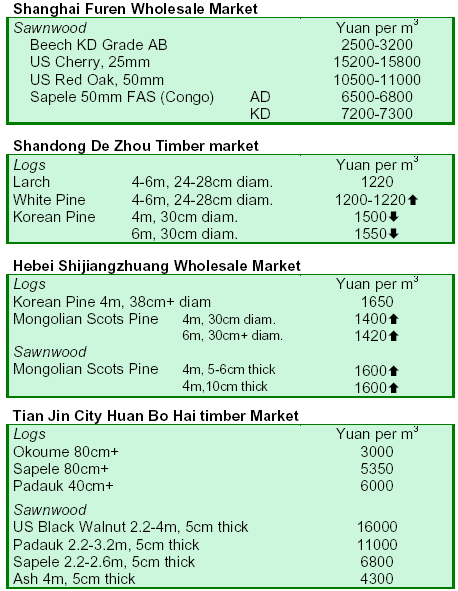US
Dollar Exchange Rates of 16th August
2007
China Yuan
7.544
Report from China
Price hike brings downturn in solid wood flooring sales
Chinese solid wood flooring manufacturers have increased their prices in response to an
increase in raw material costs, causing complaints from retailers and consumers.South
American sawn timber prices increased 30% during the year, and price rises are expected to
continue in the near term. Retailers and consumers are complaining about price hikes, since
business in China is slowing.
Coastal areas host most of China¡¯s furniture production base
China Wood Monthly reports that the concentration of furniture production areas along the
coasts has been growing. These areas have been increasing their market shares, growing to
92.6% of total exports in 2005. Guangdong, a fast increasing coastal producer area, Fujian
and Zhejiang make up 78.55% of the country¡¯s total furniture output.
State Council sets up China¡¯s national forestry industry association
On August 20, the China State Council established the China Forestry Industry Association.
The national association is a non-profit social group managed by the State Forestry
Administration and will play an active role in standardizing industry management, improving
industry planning, promoting orderly competition and serving theforestry industry. Additionally,
the association will also endeavor to improve recognition and competitive strength
of China¡¯s wood products market and move its forest industry in line with international practices. The
establishment of the association marks an important milestone in the development of China¡¯s
forestry industry.
The total output value of China¡¯s forestry industry topped RMB1 trillion and the total international trade value of
China¡¯s forestry industry was RMB47 billion in 2006,nearly three and two times
higher than in 2000, respectively. The total output value of China¡¯s forestry
industry is expected to be about RMB1.5 trillion in 2007.
Shandong Port boosts plywood exports dramatically
During the first half of 2007, Qingdao Customs reported that plywood exports through Shandong Port rose to 1.47
million m3, valued at US$460 million, up 41% in volumeand 78% in value from the same period in 2006. The
average price for exported plywood was US$310.4 per cubic meter, up 27%.
The causes of the price rise were record high prices for exported plywood through the port,
which exceeded US$300 per m3 for six consecutive months and broke US$317 per m3 in June. The main export markets of the
US, EU and ASEAN countries accounted for 69% of plywood exports through the port. Statistically, exports
from enterprises grew across the board during the first half of 2007. Private enterprises rose 40% to 969,000 m3, stateowned
enterprises rose 42% to 359,000 m3, foreign traders grew 49% to 111,000 m3, and collective enterprises
increased 29% to 32,000 m3.
Imports through Heihe Port surge across the board
Log imports through Heihe Port were 2,043 batches, 63,500 m3 and worth US$3.54 million
during the first half of 2007. The imports resulted in increases by 28.7% in
batch, 33.4% in volume and 42.9% in value from the same period in 2006. The main timber species imported
were birch and larch. Although Russia had implemented its higher log export tariff, log imports
through Heihe Port had not yet been impacted.
Zhangjiagang Port posts rapid growth in 2007
Increases of log imports through Zhangjiangang Port have been reported across the board. From January to June, log
imports through the port were 1,336 batches, 1.88 million m3 and worth US$482 million, up 40.8% in batch,
43.3%in volume and 58.6% in value from the same period in 2006. Zhangjiagang is the largest distributing centerimporting ocean shipping logs into
China.Timber imports through the port have been increasing year by year since
the port was formally opened to import logs at the end of 1982. 18.7 million m3 of logs had been imported
from 2000 to 2006.
Among the types of logs imported, African timber from Gabon and Equatorial Guinea and
Oceania timber fromPapua New Guinea and Solomon Islands featured prominently in
the imports. Log imports from Southeast Asia, mostly from Malaysia and Myanmar, continued to
decline. According to statistics, the imports for the first half of 2007 from Gabon,
EquatorialGuinea and Papua New Guinea were 636,100 m3, 211,700 m3, and 501,400
m3, up 62%, 84% and 36% respectively from the same period in 2006. However, log imports through
the port from Malaysia amounted to 85,100 m3, down 55.4% from the same period in 2006. In
addition, in the first half of 2007, 51,300 m3 of timber shipped in containers from 29
countries were imported through the port, up 72% in volume from the same period in 2006.
Timber shortages hurt China¡¯s wood markets
China Wood Monthly drew attention to China¡¯s native timber shortage. Notably, in the second
half of the year, the market had slowed and prices increased. This had been
caused by the heavy rains and flooding in areas such as Fujian, Zhejiang, Jiangxi, Anhui, Shandong, Hunan,
Hubei, Chongqing and Guangxi. The poor weather conditions made logging difficult, swept away logs and
processed wood, ruined roads and stalled other parts of the transportation system.
With the shortage of timber supply, some traders have become desperate to buy logs at high
prices. Prices for the coming months will also largely be determined by the
persistence of the rains and floods. Yet, after the rainy season, experts are optimistic that the production of timber
will return to normal.


|